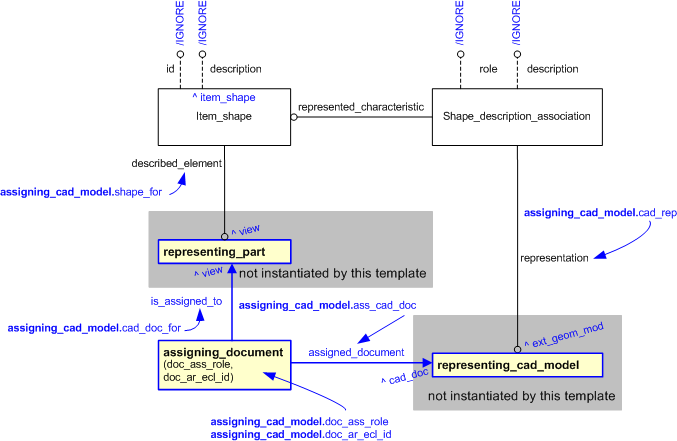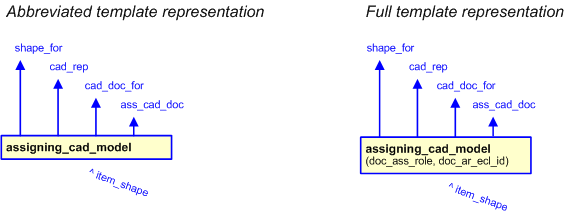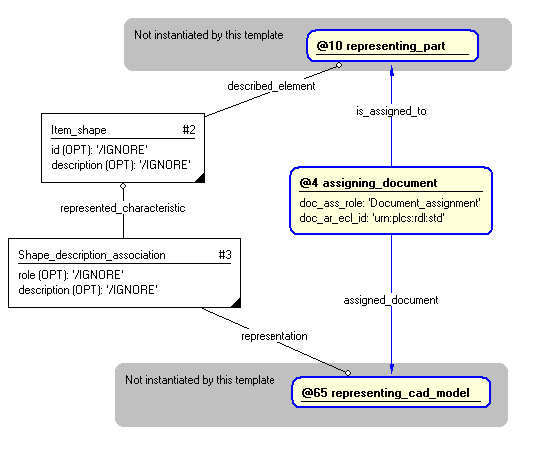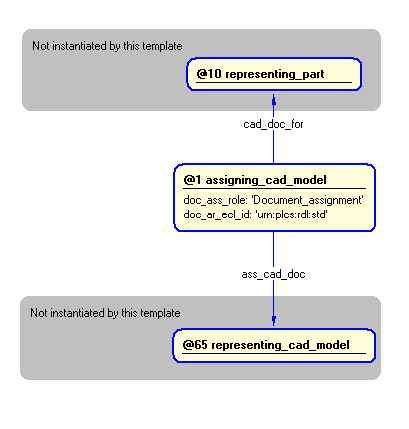Template:— assigning_cad_model (ass_cad_mod)
Capability:assigning_product_properties |
Date: 2011/10/07 08:40:46
Revision: 1.1
|
![[warning:]](../../../../images/dex/warning.gif) Error T1: There is no template_proxy in the capability assigning_product_properties for the template assigning_cad_model
Error T1: There is no template_proxy in the capability assigning_product_properties for the template assigning_cad_model
This section specifies the template assigning_cad_model.
NOTE
The template has been defined in the context of the capability
assigning_product_properties
which provides an overall description of the
relevant parts of the ISO 10303-239 information model and a description
of related templates.
NOTE
An explanation of a template and the associated instantiation path is
provided in the
Template overview
section.
This template describes how to represent the assignment of a CAD model to the part it represents.
The EXPRESS-G diagram in
Figure
1
shows the templates and EXPRESS entities that are required
to represent the template
"assigning_cad_model".
The text highlighted in blue shows the template parameters.
Figure 1 — An EXPRESS-G representation of the Information model for assigning_cad_model
The graphic for the template to be used in other EXPRESS-G diagrams
is shown in Figure
2
below.
Figure 2 — The graphical representation of the assigning_cad_model template
The following input parameters are defined for this template:
The
Document for the CAD model that represents a part.
The name of the
External_class used to
determine the role of the assignment.
The following classes and their sub-classes can be used:
The following reference parameters are defined for this template:
Allow the
Item_shape
entity instantiated in this path to be referenced when this template is used.
Note: The
Item_shape
entity can be referenced in a template path by:
%^target = $assigning_cad_model.item_shape%
where
target
is the parameter to which the
Item_shape
is bound.
The following parameter combinations specify a uniqueness constraint:
Unique constraint: Item shape
Each instance of the
entity
(
Item_shape)
within the data set shall be uniquely identified
by the following parameters on this
template (assigning_cad_model) namely:
shape_for.
The
instance is
referenced by the following template parameter:
item_shape.
The instantiation path shown below specifies the entities that are to be
instantiated by the template.
A description of templates and the syntax for the instantiation path is
provided in the
Templates Help/Information section.
The following entities are instantiated with attributes as specified:
The instance diagram in Figure
3
shows an example of the EXPRESS entities and templates that are instantiated by the template:
/assigning_cad_model(shape_for='@10', cad_doc_for='@10', cad_rep='@65', ass_cad_doc='@65', doc_ass_role='Document_assignment', doc_ar_ecl_id='urn:plcs:rdl:std')/
(an illustration of the consolidated assigning_cad_model template is shown in
Figure
4 below.)
Figure 3 — Entities instantiated by assigning_cad_model template
The instance diagram in
Figure
4
shows the graphic symbol for the template that is to be
used in other instance diagrams. The example template is:
/assigning_cad_model(shape_for='@10', cad_doc_for='@10', cad_rep='@65', ass_cad_doc='@65', doc_ass_role='Document_assignment', doc_ar_ecl_id='urn:plcs:rdl:std')/
Figure 4 — Instantiation of assigning_cad_model template
Characterizations
No common characterizations of the template
assigning_cad_model
have been identified. However, the ISO 10303-239 EXPRESS model
may enable other assignments to the entities instantiated by the template.




